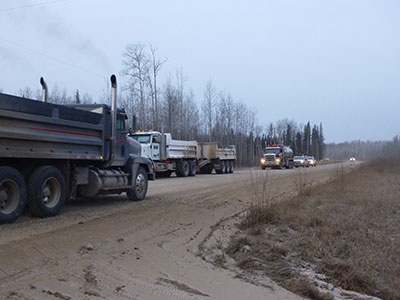
Features
Harvesting
Transportation
Traffic engineering
June 24, 2014 - Whether for the forestry, mines, or energy sector, Canada is crisscrossed by hundreds of thousands of kilometers of resources roads. With increasing traffic volumes on these roads and more industrial sectors using them, there is an urgent need to assess the influence of traffic on transport safety and productivity. In B.C., for example, the Ministry of Forests, Lands and Natural Resource Operations (FLNRO), is faced with demands for industrial developments along many portions of its network of forest service roads (FSRs). However, it does not currently have the tools to assess the influence of traffic on the productivity and safety of its resource road network, or what is known as the “safe traffic capacity.” More explicitly, safe traffic capacity is the maximum permissible traffic volume under which road user safety is not impacted. It is, of course, very important to know the safe traffic capacity of the existing network and evaluate how it can be increased (e.g., with traffic controls or road upgrades) in order to accommodate current and future growth in resource road traffic.
Being well aware of FPInnovations’ expertise in the field of transportation and resource roads, the FLNRO mandated the Resource Roads research group to support their decision-making process with hard data. The mandate is to create a traffic flow model specifically designed for the province’s resource roads, as well as the impact of innovative solutions that could mitigate traffic issues wherever found.
Both summer and winter surveys were performed in 2013. Key variables that we found to influence traffic on resource roads were eventually classified into two categories: safety and productivity. Road design and maintenance, speed, personal impairment and lack of radio communication are the predominant contributing road collision factors on resource roads in B.C., as identified by WorkSafe BC in a study in July 2009. However, the influence of these factors on safety is not easy to measure or quantify.
Crash or collision statistics are the preferred basis for researching traffic safety, but collision data for B.C. resource roads are gathered by a variety of agencies and data vary by agency mandate. If collision data cannot be found to support an analysis, measures such as level of service and trip delays may offer alternative ways to assess road user safety. Productivity was taken into account by evaluating the fundamental traffic measures of speed, flow and density. These variables were analyzed as a function of seasonality, time of day, day of the week, road alignment (grades and horizontal curves), and pull-out use.
Much stills needs to be done to assess the safe traffic capacity of Canada’s resource roads. For B.C., one thing that would greatly help is if a comprehensive database were created of the number and types of crashes that occur on forest service roads in B.C. That would truly be an essential step for evaluating traffic safety on B.C. resource roads. Our research has also sparked an interest from members in other provinces. As such, FPInnovations is currently collecting data on high traffic resource roads in Alberta where traffic volumes of over 1,000 vehicles per day have been documented. Funding for this research is also supported by NRCan’s Transformative Technologies program.
Allan Bradley is the Associate Research Leader of Resource Roads, Forest Operations. For more information on traffic engineering, please contact him at allan.bradley@fpinnovations.ca.
June 24, 2014 By Allan Bradley
 Whether for the forestry
Whether for the forestryPrint this page